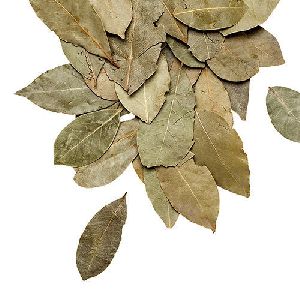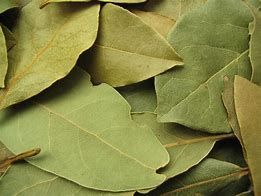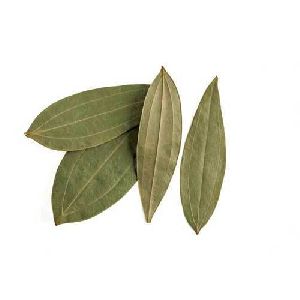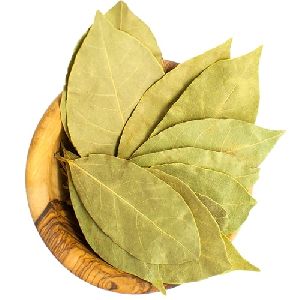
Dried Bay Leaves
Get Price Quote
50 Kilogram (MOQ)

Dried Bay Leaves
Get Price Quote
100 Kilogram (MOQ)
Best Deals from Dried Bay Leaves

Dried Bay Leaves
Get Price Quote
10 Ton (MOQ)

Dried Bay Leaves
Get Price Quote

Dried Bay Leaf
Get Price Quote
1 Ton (MOQ)

Dried Bay Leaves
Get Price Quote
Description : Bay leaves come from several plants, such as : Bay laurel (Laurus nobilis, Lauraceae). Fresh or dried bay leaves are used in cooking for their distinctive flavour and fragrance. The leaves should be removed from the cooked food before eating (see Safety section below). The leaves are often used to flavour soups, stews, braises and pâtés in many countries. The fresh leaves are very mild and do not develop their full flavour until several weeks after picking and drying. California bay leaf – the leaf of the California bay tree (Umbellularia californica, Lauraceae), also known as California laurel, Oregon myrtle, and pepperwood, is similar to the Mediterranean bay laurel, but has a stronger flavour. Indian bay leaf or malabathrum (Cinnamomum tamala, Lauraceae) differs in that bay laurel leaves are shorter and light to medium green in colour, with one large vein down the length of the leaf, while tejpat (Cinnamonum tamala) leaves are about twice as long and wider, usually olive green in colour, and with three veins down the length of the leaf and is culinarily quite different, having a fragrance and taste similar to cinnamon (cassia) bark, but milder. Indonesian bay leaf or Indonesian laurel (salam leaf, Syzygium polyanthum, Myrtaceae) is not commonly found outside Indonesia; this herb is applied to meat and, less often, to vegetables. West Indian bay leaf, the leaf of the West Indian bay tree (Pimenta racemosa, Myrtaceae), used culinarily (especially in Caribbean cuisine) and to produce the cologne called bay rum. Mexican bay leaf (Litsea glaucescens, Lauraceae). Chemical constituents :The leaves contain about 1.3% essential oils (ol. lauri folii), consisting of 45% eucalyptol, 12% other terpenes, 8-12% terpinyl acetate, 3–4% sesquiterpenes, 3% methyleugenol, and other α- and β-pinenes, phellandrene, linalool, geraniol, terpineol, and contain lauric acid also.Taste and aroma:If eaten whole, bay leaves (Laurus nobilis) are pungent and have a sharp, bitter taste. As with many spices and flavourings, the fragrance of the bay leaf is more noticeable than its taste. When dried, the fragrance is herbal, slightly floral, and somewhat similar to oregano and thyme. Myrcene, which is a component of many essential oils used in perfumery, can be extracted from the bay leaf. Uses: In Indian cuisine, bay laurel leaves are sometimes used in place of Indian bay leaf, although they have a different flavour. They are most often used in rice dishes like biryani and as an ingredient in garam masala. Bay (laurel) leaves are frequently packaged as tejpatt? The Hindi term for Indian bay leaf), creating confusion between the two herbs. In the Philippines, dried bay laurel leaves are used in several Filipino dishes such as menudo, beef pares, and adobo. Bay leaves can also be crushed or ground before cooking. Crushed bay leaves impart more fragrance than whole leaves, but are more difficult to remove, and thus they are often used in a muslin bag or tea infuser. Ground bay laurel may be substituted for whole leaves, and does not need to be removed, but it is much stronger. Bay leaves are also used in the making of jerk chicken in the Caribbean Islands. The bay leaves are soaked and placed on the cool side of the grill. Pimento sticks are placed on top of the leaves and the chicken is placed on top and smoked. The leaves are also added whole to soups, stews, and other Caribbean dishes. Varieties :Indian Cassia also known as Tejpat (Cinnamomum Tamala) is a small to moderately sized ever green tree. The leaves of this tree is the spice having clove like taste and a faintly pepper like odour. The tree has height up to 7.5 mtr with zigzag branching, trunk up to 95 cm girth, bark rough, dark grey to reddish brown in colourManagementTo start with, nurseries were raised through grafting method in convergence with Horticulture department. 32 SHGs were selected for raising nurseries.It is estimated that after the end of the third year the farmers will earn about Rs. 500.00 per plant per year and after 6 years the farmers will earn around Rs. 1,000.00 per plant per year. In the meantime, the farmers have also been encouraged to resort to intercropping. Vegetables or pulse can be practised for inter-cropping for initial 1 to 2 years and later any shade loving crop can be cultivated. It is hoped that the farmers will get financial security by growing bay leaf.Irrigation/CultivationThese trees require full sunlight. They grow well in warm and moist climates. Bay leaves grow well in fertile, well drained soils with good organic matter.They thrive best in the soils with PH of 6.0 to 8.0.

Dried Bay Leaves
Get Price Quote
Dried Bay Leaves (Tej Patta): Dried Bay Leaves (Tej Patta) are useful in beans, split peas, vegetable stews, spaghetti sauce, etc. to enhance the aroma. To add the richness, depth and flavour, the sweet bay leaves are the best option. The bay leaves are very delicate and need extensive care in the handling. We provide wholesale bay leaves to our customers as profitable deals. We are one of the prominent bay leaves exporters from India.

Dry Bay Leaves
Get Price Quote
Dry Bay Leaves, Black Pepper Seeds, dry curry leaves, mace seed